

Diamond Oceans Possible on Uranus, Neptune. - Like ice on water, solid diamond floats on liquid diamond. - The finding explains possible liquid diamond oceans on other planets. - Diamond oceans may cause off-kilter planetary tilts.

Oceans of liquid diamond, filled with solid diamond icebergs, could be floating on Neptune and Uranus, according to a recent article in the journal Nature Physics. The research, based on the first detailed measurements of the melting point of diamond, found diamond behaves like water during freezing and melting, with solid forms floating atop liquid forms. The surprising revelation gives scientists a new understanding about diamonds and some of the most distant planets in our solar system. "Diamond is a relatively common material on Earth, but its melting point has never been measured," said J. Other groups, notably scientists from Sandia National Laboratories, successfully melted diamond years ago, but they were unable to measure the pressure and temperature at which the diamond melted.
NEPTUNE - SOUNDS FROM SPACE - NASA VOYAGER I - II RECORDINGS. Astrophile: The outermost ocean in the solar system - space - 25 May 2012. Astrophile is our weekly column on curious cosmic objects, from the solar system to the far reaches of the multiverse Object: Triton's subsurface oceanTemperature: About -90 °C A new day dawns on Triton.
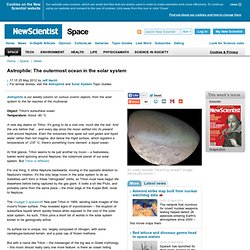
It's going to be a cold one, much like the last. And the one before that… and every day since the moon settled into its present orbit around Neptune. Even the volcanoes here spew out cold gases and liquid water rather than hot magma. At first glance, Triton seems to be just another icy moon – a featureless, barren world spinning around Neptune, the outermost planet of our solar system. For one thing, it orbits Neptune backwards, moving in the opposite direction to Neptune's rotation. The Voyager 2 spacecraft flew past Triton in 1989, sending back images of the moon's frozen surface. Its surface ice is unique, too: largely composed of nitrogen, with some cantaloupe-textured terrain, and a polar cap of frozen methane. We know that Triton was captured by Neptune. More From New Scientist. Pictures of Neptune. Want to stay on top of all the space news?
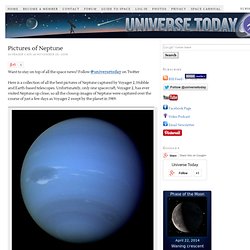
Follow @universetoday on Twitter. Voyager Neptune Photos & Planet Neptune. Hubble Discovers New Neptune Moon. Astronomers using the Hubble Space Telescope have found another moon circling Neptune, a giant planet located about 30 times farther away from the sun than Earth.

The new moon was too small to be noticed by Voyager 2′s cameras when it completed its flyby of the planet in 1989. Talking Smack: The Asteroid Collision Quiz The newly found moon, temporarily designated S/2004 N 1, brings Neptune’s orbital brood to 14. With an estimated diameter of no more than 12 miles, the new moon is Neptune’s smallest. S/2004 N 1 is located about 65,400 miles from the planet, between the orbits of sister moons Larissa and Proteus, and it circles Neptune about every 23 hours. Credit for the discovery goes to Mark Showalter, with the SETI Institute in Mountain View, Calif., who was studying archived images of Neptune taken by the Hubble observatory between 2004 and 2009. ANALYSIS: Neptune and Uranus Possess Weird Jet Streams No immediate word on what its new name may be. Neptune's strange new moon is first found in a decade - space - 15 July 2013.
Neptune has a new moon, and its existence is an enigma.
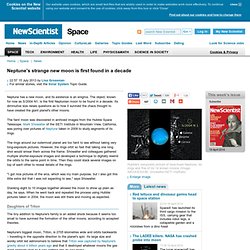
The object, known for now as S/2004 N1, is the first Neptunian moon to be found in a decade. Its diminutive size raises questions as to how it survived the chaos thought to have created the giant planet's other moons. The faint moon was discovered in archived images from the Hubble Space Telescope. Mark Showalter of the SETI Institute in Mountain View, California, was poring over pictures of Neptune taken in 2009 to study segments of its rings.
The rings around our outermost planet are too faint to see without taking very long-exposure pictures. "I got nice pictures of the arcs, which was my main purpose, but I also got this little extra dot that I was not expecting to see," says Showalter. Stacking eight to 10 images together allowed the moon to show up plain as day, he says. Are There Oceans on Neptune? Want to stay on top of all the space news?
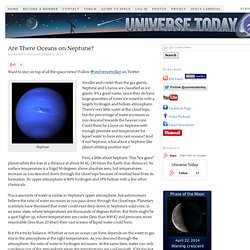
Follow @universetoday on Twitter Neptune Smaller and cooler than the gas giants, Neptune and Uranus are classified as ice giants. It’s a good name, since they do have large quantities of water ice mixed in with a largely hydrogen and helium atmosphere. There’s very little water at the cloud tops, but the percentage of water increases as you descend towards the heavier core. Trace amounts of water is visible in Neptune’s upper atmosphere, but astronomers believe the ratio of water increases as you pass down through the cloud tops.
But it’s a tricky balance. But if the temperatures are cool enough at the right pressures, and there’s enough water in the atmosphere, it should condense out to form an ocean layer before the clouds begin. Researchers Sloane J. According to data gathered from here on Earth and the Voyager spacecraft, Neptune is probably too dry and too warm for these oceans to form. Written by Fraser Cain. A Warm South Pole? Yes, On Neptune! An international team of astronomers using ESO's Very Large Telescope has discovered that the south pole of Neptune is much hotter than the rest of the planet.

This is consistent with the fact that it is late southern summer and this region has been in sunlight for about 40 years. Astrophile: Lost moon Naiad swims back into view - space - 08 October 2013. Astrophile is our weekly column on curious cosmic objects, from the solar system to the far reaches of the multiverse Object: Neptune's tiny moon, NaiadSize: 100 kilometres acrossFavourite game: Hide and seek Neptune's moon Naiad is a coy sprite.
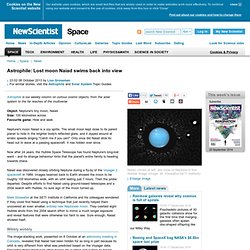
The small moon kept close to its parent planet to hide in the brighter body's reflected glare, and it zipped around at erratic speeds singing "Catch me if you can! " Only once did Naiad stick its head out to wave at a passing spacecraft. It has hidden ever since.